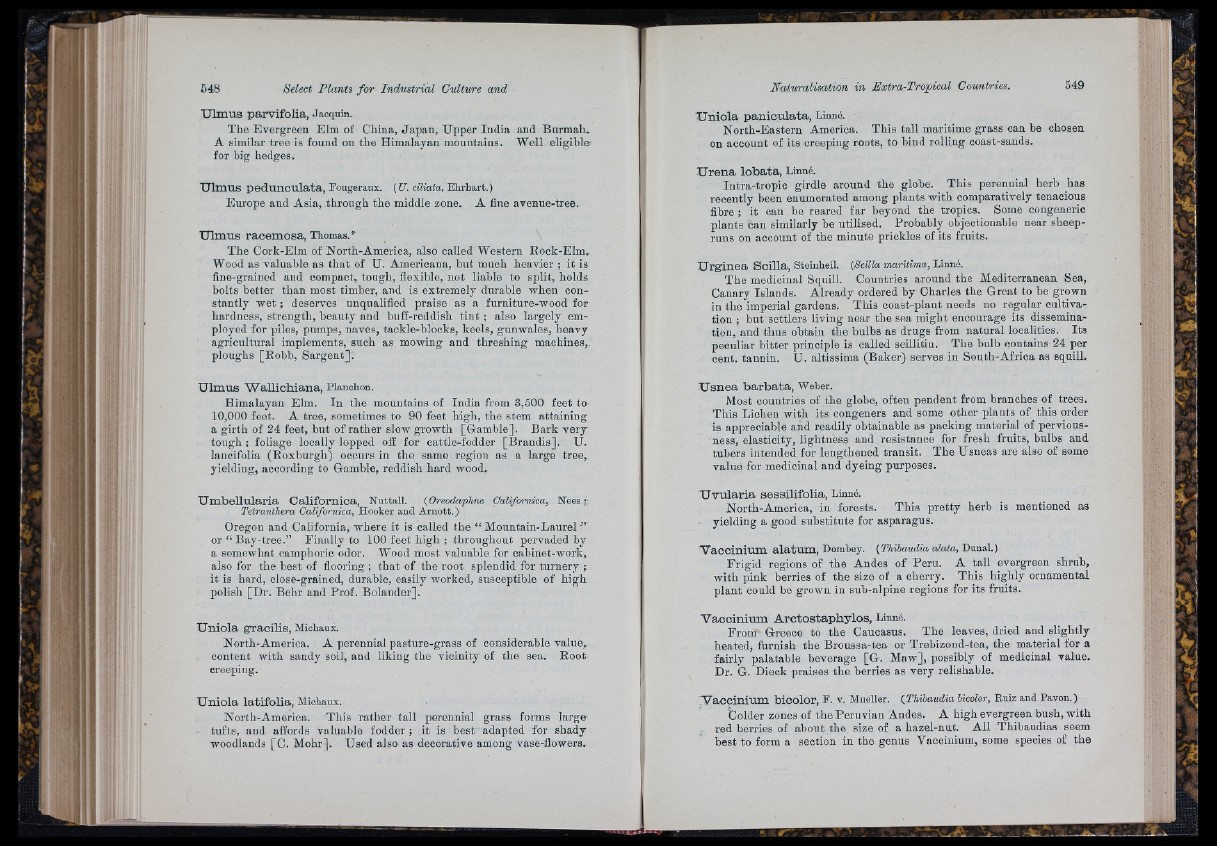
Ulmus parvifolia, Jacquin.
The Evergreen Elm of China, Japan, Upper India and Burmah.-
A similar tree is found on the Himalayan mountains. Well eligible-
for big hedges.
Ulmus pedunculata, Fougeraux. [XI. ciliata, Ehrhart.)
Europe aud Asia, through the middle zone. A fine avenue-tree.
Ulmus racemosa, Thomas.*
The Cork-Elm of North-America, also called Western Rock-Elm.
Wood as valuable as th a t of Ü. Americana, but much heavier ; it is
fine-grained and compact, tough, flexible, not liable to split, holds
bolts better than most timber, and is extremely durable when constantly
wet ; deserves unqualified praise as a furniture-wood for
hardness, strength, beauty and buff-reddish tin t ; also largely employed
for piles, pumps, naves, tackle-hlocks, keels, gunwales, heavy
agricnltnrai implements, such as mowing and threshing machines,,
ploughs [Robb, Sargent].
Ulmus ■Wallichiana, Planchón.
Himalayan Elm. In the mountains of India from 3,500 feet to
10,000 feet. A tree, sometimes to 90 feet high, the stem attaining
a girth of 24 feet, but of rather slow growth [Gamble]. Bark very
tough ; foliage locally lopped off for cattle-fodder [Brandis]. U.
lancifolia (Roxburgh) occurs in the same region as a large tree,,
yielding, according to Gamble, reddish hard wood.
Umbellularia Californica, Nuttall. (Oreodaphne Californica, Nees ;■
Tetranfhera Galifornica, Hooker and Arnott.)
Oregon and California, where it is called the “ Mountain-Laurel ”
or “ Bay-tree.” Finally to 100 feet high ; throughout pervaded by
a somewhat camphoric odor. Wood most valuable for cabinet-work,
also for the best of flooring ; th a t of the root splendid for turnery ;
it is hard, close-grained, durable, easily worked, susceptible of high
polish [Dr. Behr and Prof. Bolander],
Unióla gracilis, Michaux.
North-America. A perennial pasture-grass of considerable value,
content with sandy soil, and liking the vicinity of the sea. Root
creeping.
Unióla latifolia, Michaux.
North-America. This rather tall perennial grass forms large
tufts, and affords valuable fodder ; it is best adapted for shady
woodlands [C. Mohr]. Used also as decorative among vase-flowers.
Unióla paniculata, Linné.
North-Eastern America. This tall maritime grass can he chosen
on account of its creeping roots, to hind rolling coast-sands.
Urena lobata, Linné.
Intra-tropic girdle around the globe. This perennial herb has
recently been enumerated among plants with comparatively tenacious
fibre ; it can be reared far beyond the tropics. Some congeneric
plants can similarly be utilised. Probably objectionable near sheep-
runs on account of the minute prickles of its fruits.
Urginea Scilla, Steinheil. (Scilla maritima, Linné.
The medicinal Squill. Countries around the Mediterranean Sea,
Canary Islands. Already ordered by Charles the Great to he grown
in the imperial gardens. This coast-plant needs no regular oultivation
; but settlers living near the sea might encourage its dissemination,
and thus obtain the bulbs as drugs from natural localities. Its
peculiar bitter principle is called scillitin. The bulb contains 24 per
cent, tannin. U. altissima (Baker) serves iu South-Africa as squill.
Usnea barbata, Weber.
Most countries of the globe, often pendent from branches of trees.
This Lichen with its congeners and some other plants of this order
is appreciable and readily obtainable as packing material of pervions-
ness, elasticity, lightness aud resistance for fresh fruits, bulbs and
tubers intended for lengthened transit. The Usneas are also of some
value for medicinal and dyeing purposes.
Uvularia sessilifolia, Linné.
North-Amerioa, in forests. This pretty herb
yielding a good substitute for asparagus.
mentioned as
Vaccinium alatum, Dombey. ( Thihaudia alata, Dunal. )
Frigid regions of the Andes of Peru. A tall evergreen shrub,
with pink berries of the size of a cherry. This highly ornamental
plant could be grown iu sub-alpine regions for its fruits.
Vaccinium Arctostaphylos, Linné.
From Greece to the Caucasus. The leaves, dried and slightly
heated, furnish the Broussa-tea or Trebizond-tea, the material for a
fairly palatable beverage [G. Maw], possibly of medicinal value.
Dr. G. Dieck praises the berries as very relishable.
Vaccinium bicolor, F. v. Mueller. {Thihaudia bicolor, E,uiz and Pavon.)
Colder zones of the Peruvian Andes. A high evergreen bush, with
red berries of ahout the size of a hazel-nut. All Thibaudias seem
best to form a section in the genus Vaccinium, some species of the